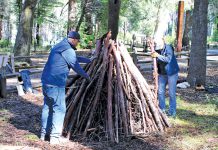During the post-pandemic rebound, and with the addition of Target, money flooded back into municipal coffers. However, in recent months, the City of Scotts Valley has watched as its sales tax revenue declined somewhat.
And, during the mid-year budget update at the regularly-scheduled Council meeting Feb. 5, staff sought to paint the community in a favorable light, by noting other jurisdictions have seen a worse decline.
“The Fiscal Year 2023-24 audit results finished $800,000 better than what the budget was,” said Administrative Services Director Stephanie Hill. “A lot of this came from stronger revenues.”
This comes as administrators have been more careful about charging fees at the departmental level so that the General Fund balance is protected, according to the City.
Meanwhile, storm repairs that were originally under the capital budget were transferred to the operations budget, since nothing new was being created.
“We had to recognize all of those expenditures as operating expenses in the General Fund,” Hill said. “There were also some operational savings, as the City wasn’t fully staffed during the 2023-24 Fiscal Year.”
Scotts Valley ultimately generated $19.1 million in revenue (for 2023-24) and had $19.5 million in expenditures. Hill said most recurring General Fund revenues were performing as anticipated.
“However, there has been a decline in sales and use tax revenues being seen across the state,” Hill wrote in her report to Council that day. “Offsetting the decline were increases in areas such as Utility Users Tax, likely related to increased fees from the utilities, and permit related revenues.”
No one seemed too alarmed by the overall picture.
This comes as Scotts Valley was $1.7 million ahead of where it expected to be, in terms of revenue for Fiscal Year 2023-24. However, this was offset by $900,000 of additional spending.
“Roughly half of the revenue increase was related to the new cost allocation analysis that realigned internal service department charges for services provided to other funds and close out of certain grant programs,” Hill noted. “Franchise and Utility Users revenues came in stronger than anticipated, as well as greater investment income due to the interest rates remaining strong all year. Expenses came in higher due to storm repairs to the Green Hills Road and Bean Creek Road.”
Scotts Valley expects to be reimbursed for a portion of these natural disaster responses.
So, while staff forecast $7.4 million in sales and use tax coming in, Scotts Valley only collected $7 million.
However, the City was anticipating $975,000 in Utility Users Tax revenue, but pulled in $1.2 million (a net positive of $225,000). Permit revenue was predicted at $684,000, but actually came in as $895,000 ($211,000 higher than expected).
Scotts Valley got $50,000 more in business license tax revenue than staff thought would arrive.
Meanwhile, police fees were up from $16,000 to $30,000 (a $14,000 boost to the bottom line).
On the other hand, building contract services expenses were budgeted at $400,000, but came in at $300,000. Staff said this savings was due to the City being fully staffed. After all, you don’t need to contract out services if you have people in house that can do the job.
No members of the public contributed during the public comment period.
Councilmember Donna Lind said she was appreciative of the hard work of the City’s finance team.
“It’s a heavy lift,” she said. “We know it.”
Mayor Derek Timm said it can be a little counterintuitive to think that by hiring staff you would save money.
“But you see that in the real dollars,” he said, “—what our Public Works crews are able to accomplish on their own versus going to outside resources.”
He said it’s the first time “in many, many years” that the City has been fully staffed.
“Kudos to everything that’s going on in management,” he said. “It is frustrating that we’ve finished these projects and we’re waiting on $2 million—and also fighting with the state on CBDG money that we should be receiving. That’s challenging, because we have to carry those dollars in the interim. And those are big numbers. Rather than being in our balances and turning a 4% interest rate, they’re sitting in the federal government, or State government’s, coffers.”
Timm said the community’s State and Congressional representatives have been working with Scotts Valley to try to “go after” those dollars.











